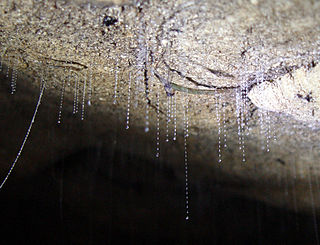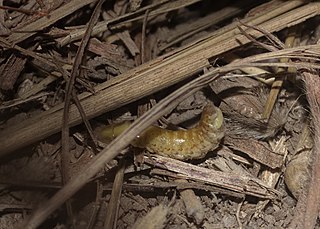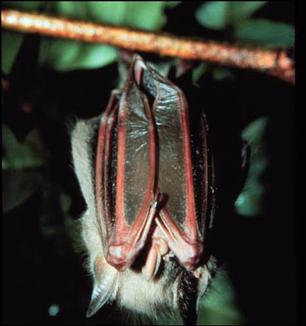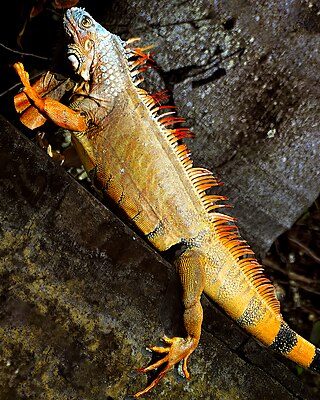
The cane toad, also known as the giant neotropical toad or marine toad, is a large, terrestrial true toad native to South and mainland Central America, but which has been introduced to various islands throughout Oceania and the Caribbean, as well as Northern Australia. It is a member of the genus Rhinella, which includes many true toad species found throughout Central and South America, but it was formerly assigned to the genus Bufo.

Beetles are insects that form the order Coleoptera, in the superorder Endopterygota. Their front pair of wings are hardened into wing-cases, elytra, distinguishing them from most other insects. The Coleoptera, with about 400,000 described species, is the largest of all orders, constituting almost 40% of described insects and 25% of all known animal species; new species are discovered frequently, with estimates suggesting that there are between 0.9 and 2.1 million total species. Found in almost every habitat except the sea and the polar regions, they interact with their ecosystems in several ways: beetles often feed on plants and fungi, break down animal and plant debris, and eat other invertebrates. Some species are serious agricultural pests, such as the Colorado potato beetle, while others such as Coccinellidae eat aphids, scale insects, thrips, and other plant-sucking insects that damage crops.

The Lampyridae are a family of elateroid beetles with more than 2,000 described species, many of which are light-emitting. They are soft-bodied beetles commonly called fireflies, lightning bugs, or glowworms for their conspicuous production of light, mainly during twilight, to attract mates. Light production in the Lampyridae is thought to have originated as an honest warning signal that the larvae were distasteful; this was co-opted in evolution as a mating signal in the adults. In a further development, female fireflies of the genus Photuris mimic the flash pattern of Photinus species to trap their males as prey.

Bioluminescence is the production and emission of light by living organisms. It is a form of chemiluminescence. Bioluminescence occurs widely in marine vertebrates and invertebrates, as well as in some fungi, microorganisms including some bioluminescent bacteria, and terrestrial arthropods such as fireflies. In some animals, the light is bacteriogenic, produced by symbiotic bacteria such as those from the genus Vibrio; in others, it is autogenic, produced by the animals themselves.

The rhesus macaque, colloquially rhesus monkey, is a species of Old World monkey. There are between six and nine recognised subspecies that are split between two groups, the Chinese-derived and the Indian-derived. Generally brown or grey in colour, it is 47–53 cm (19–21 in) in length with a 20.7–22.9 cm (8.1–9.0 in) tail and weighs 5.3–7.7 kg (12–17 lb). It is native to South, Central, and Southeast Asia and has the widest geographic range of all non-human primates, occupying a great diversity of altitudes and a great variety of habitats, from grasslands to arid and forested areas, but also close to human settlements. Feral colonies are found in the United States, thought to be either released by humans or escapees after hurricanes destroyed zoo and wildlife park facilities.

The Puerto Rican dry forests are a tropical dry forest ecoregion located in southwestern and eastern Puerto Rico and on the offshore islands. They cover an area of 1,300 km2 (500 sq mi). These forests grow in areas receiving less than 1,000 mm (39 in) of rain annually. Many of the trees are deciduous, losing their leaves during the dry season which normally lasts from December to April.

The Elateroidea are a large superfamily of beetles. It contains the familiar click beetles, fireflies, and soldier beetles and their relatives. It consists of about 25,000 species.

The rosy-faced lovebird, also known as the rosy-collared or peach-faced lovebird, is a species of lovebird native to arid regions in southwestern Africa such as the Namib Desert. Loud and constant chirpers, these birds are very social animals and often congregate in small groups in the wild. They eat throughout the day and take frequent baths. Coloration can vary widely among populations. Plumage is identical in males and females. Lovebirds are renowned for their sleep position in which they sit side-by-side and turn their faces in towards each other. Also, females are well noted to tear raw materials into long strips, "twisty-tie" them onto their backs, and fly substantial distances back to make a nest. These birds are common in the pet industry.

The Puerto Rican spindalis is a bird endemic to the island of Puerto Rico, where it is commonly known as reina mora. The species is widely distributed throughout the island and is an important part of the Puerto Rican ecosystem because of its help in seed dispersal and plant reproduction. The Puerto Rican spindalis is the unofficial national bird of Puerto Rico.

Arachnocampa luminosa, commonly known as New Zealand glowworm or simply glowworm, is a species of fungus gnat endemic to New Zealand. The larval stage and the imago produce a blue-green bioluminescence. The species is known to dwell in caves and on sheltered banks in native bush where humidity is high. Its Māori name is titiwai, meaning "projected over water".

Adelaide's warbler is a bird endemic to the archipelago of Puerto Rico belonging to the genus Setophaga of the family Parulidae. The species is named after Adelaide Swift, daughter of Robert Swift, the person who captured the first specimen.

The firefly squid, also commonly known as the sparkling enope squid or hotaru-ika in Japan, is a species of squid in the family Enoploteuthidae. W. scintillans is the sole species in the monotypic genus Watasenia. These tiny squid are found on the shores of Japan in springtime during spawning season, but spend most of their lives in deeper waters between 200 and 400 metres. They are bioluminescent organisms and emit blue light from photophores, which some scientists have hypothesized could be used for communication, camouflage, or attracting food, but it is still unclear in the scientific community exactly how this species uses their bioluminescence. The firefly squid is a predator and actively hunts its food, which includes copepods, small fish, and other squids. The lifespan of a firefly squid is about one year. At the end of their lives, females return close to shore to release their eggs and then die shortly thereafter. This mass migration of firefly squid to the shore is a lucrative business for Japanese fishermen, and during spawning season many go out to the bays to collect the dying squid. Many more also visit Japan during spawning season to see the bright blue light created from the firefly squid's bioluminescence light up the bay, making their spawning season not only a fishing opportunity but also a tourist attraction.

The Rhagophthalmidae are a family of beetles within the superfamily Elateroidea. Members of this beetle family have bioluminescent organs on the larvae, and sometimes adults, and are closely related to the Phengodidae, though historically they have been often treated as a subfamily of Lampyridae, or as related to that family. Some recent evidence suggested that they were the sister group to the Phengodidae, and somewhat distantly related to Lampyridae, whose sister taxon was Cantharidae, but more reliable genome-based phylogenetics placed as the sister group to the Lampyridae.

The pearly-eyed thrasher is a bird in the thrasher family Mimidae. It is found on many Caribbean islands, from the Bahamas in the north to the Grenadines in the south, with an isolated subspecies on Bonaire.

The red fruit bat or red fig-eating bat is a species of bat in the family Phyllostomidae, in the monotypic genus Stenoderma. It is found in Puerto Rico and the U.S. Virgin Islands.

Iguana is a genus of herbivorous lizards that are native to tropical areas of Mexico, Central America, South America, and the Caribbean. The genus was first described in 1768 by Austrian naturalist Josephus Nicolaus Laurenti in his book Specimen Medicum, Exhibens Synopsin Reptilium Emendatam cum Experimentis circa Venena. Two species are placed in the genus, the green iguana, which is widespread throughout its range and a popular pet, and the Lesser Antillean iguana, which is native to the Lesser Antilles. Genetic analysis indicates that the green iguana may comprise a complex of multiple species, some of which have been recently described, but the Reptile Database considers all of these as subspecies of the green iguana.

Photinus pyralis, known by the common names common eastern firefly and big dipper firefly, is the most common species of firefly in North America. P. pyralis is a flying and light-producing beetle with a light organ on the ventral side of its abdomen. This organism is sometimes incorrectly classified as Photuris pyralis, which likely results from mistaking the similar-sounding genus Photuris.

Pyrophorus noctilucus, common name headlight elater, is a species of click beetle.

Aquatica lateralis, known as "heike-botaru" (ヘイケボタル) in Japanese, is a species of firefly found in Russia, Japan and Korea. It was formerly placed in the genus Luciola. The larvae are aquatic and live in rice paddies.
Las Bocas Canyon is a steep gorge formed by the Frío River and numerous other creeks, primarily the Hondo River and the Grande Creek located in the Cordillera Central of Puerto Rico, between the municipalities of Barranquitas and Comerío. The canyon is notable for its untouched forests and the large population of kapok. The canyon, along with San Cristóbal Canyon, its larger southern neighbor, form part of the La Plata River basin.



















